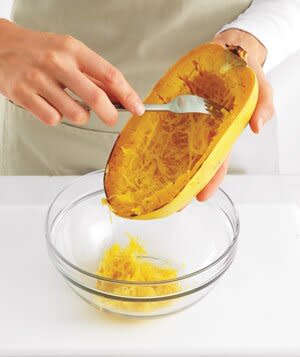3 Nutritious Reasons to Eat Spaghetti Squash—and Tasty Recipes to Make

Adobe Stock
Digging into a tasty spaghetti squash-based meal is like taking a bite of history. According to the Library of Congress, squashes are one of the oldest known crops, dating back some 10,000 years in places like Mexico. And they've never really wavered in popularity. If you aren't already enjoying this delicious gourd, you may want to start when you hear about some of its major nutritional benefits. Here's what you need to know about spaghetti squash and how to incorporate it into your daily meals.
RELATED: The 30 Healthiest Foods to Eat Every Day
History of Spaghetti Squash
According to the Library of Congress, squashes most likely served as containers or utensils because of their hard shells. "The seeds and flesh later became an important part of the pre-Columbian Indian diet in both South and North America. De Soto, Coronado, and Cartier all saw 'melons' (probably squash) in the Americas."
As for the name, the word "squash" comes from the "Narragansett Native American word askutasquash, which means eaten raw or uncooked." Though spaghetti squash is native to Mexico and Central America, it is now grown all over the world. It is classified as a winter squash like pumpkin, butternut, acorn, and delicata.
RELATED: 3 Unexpected Canned Pumpkin Recipes
Nutritional Benefits
Spaghetti squash abounds with nutritional benefits. It's low in calories and packed with satiating fiber. Keep reading to learn some ways spaghetti squash can improve your overall health.
It's packed with vitamins.
Kimberly Asman, the dietitian for Weis Markets, urges people to include spaghetti squash into their diets because it's loaded with vitamins C and K. Vitamin C acts as an antioxidant, which means it boosts your immune system and protects your memory as you age, among other things, while vitamin K helps blood clot properly and is essential in healing wounds.
It boosts digestive health.
Spaghetti squash is an excellent source of fiber, with one cup clocking in at 2.2 grams, or 9 percent of a person's daily fiber needs. This helps to promote good digestive health and keep things moving.
Josh Schlottman, a certified personal trainer and nutritionist, suggests finding ways to incorporate some squash every day. "People should add it to their daily diet by including it in salads, soups, or roasted with other vegetables," he says.
It can improve blood pressure.
According to Harvard's T.H. Chan School of Public Health, winter squash (like spaghetti squash) is rich in potassium, which can help to counteract the deleterious effects of sodium on blood pressure. Experts think it might also help to control cholesterol. According to a study that appeared in the journal Plant Foods for Human Nutrition, decreased cholesterol was observed when giving winter squash polysaccharides (a type of carbohydrates) to healthy and diabetic mice.
RELATED: 10 Top Heart-Healthy Foods You'll Love Eating
When to Buy It and How to Store It
Spaghetti squash can be found year-round, but it's best in the fall and winter when it's in season. Once cut, spaghetti squash should be kept in the refrigerator and used within a few days.
To freeze cooked spaghetti squash, let it cool completely and transfer it to freezer-safe plastic bags or food storage containers. Avoid freezer burn by squeezing as much air as possible out of the bags. The frozen spaghetti squash will last in the freezer for approximately seven months.
RELATED: 7 Foods to Consider Freezing Right Now
How to Cook It
Asman suggests cutting the squash in half lengthwise and removing the seeds. Drizzle the insides with olive oil, and place the squash cut-side down on a baking sheet. Use a fork to poke a few holes in the top, and roast it for about 30 to 40 minutes at 400 F, until it's lightly browned. Once it's cooled, use a fork to scrape the strands out of the inside of the squash.
You can also enjoy spaghetti squash by popping it into the microwave. Cut it in half lengthwise, take out the seeds, place it cut-side down in a 9 by 13-inch glass baking dish, and pierce the skin. Add 1 cup of water to the baking dish about halfway through. Adding the water will help to steam the squash and soften it so you can easily pull out the "spaghetti strings." Microwave on high for 15 minutes. Be careful removing it from the microwave, as it will be very hot.
RELATED: These Microwave Hacks Will Save You Major Time in the Kitchen
Recipes
"Once cooked, spaghetti squash shreds into spaghetti-like pieces," Asman explains. "It can be enjoyed on its own, flavored with olive oil and your favorite seasonings, or topped with pasta sauce like regular spaghetti."
Truly, spaghetti squash is a blank slate, ready for you to top it with whatever you'd like to make it your own. Scroll down for some spaghetti squash recipe ideas.
Spaghetti Squash Ragù
This hearty, slow-cooker ragù is made with familiar ingredients such as ground beef, crushed tomatoes, and oregano, but instead of topping noodles, this sauce adds some flavor to spaghetti squash. The best part? You can cook the spaghetti squash and the ragù in the slow cooker at the same time, which translates to less prep work for you and an easy cleanup.
RELATED: 35 Satisfying Vegetarian Recipes That Are Incredibly Easy to Make

Spaghetti Squash Parmesan
This vegetarian-friendly dish treats spaghetti squash just like, well, spaghetti. The veggie noodles are topped with jarred marinara sauce, ricotta, mozzarella, and grated Parmesan cheese, as well as crispy panko breadcrumbs. And if you hate doing dishes, you'll be happy to know that you can use the hollowed out squash as a bowl for this comforting meal.

Spaghetti Squash Casserole With Ricotta and Spinach
This healthy-ish casserole uses spaghetti squash as a base. The gourd is paired with ricotta, spinach, and mozzarella, and the result is a veggie-filled take on lasagna.

Instant Pot Spaghetti Squash
If you're looking for a set-it-and-forget-it kind of meal, prepare your spaghetti squash in an Instant Pot. The hands-off cooking method takes about 20 minutes and leaves you with a perfectly cooked gourd that's ready to be eaten. Top it with your favorite sauce, such as a homemade pesto, or some of Trader Joe's new Truffle Picante Spicy Pasta Sauce.


 Yahoo Movies
Yahoo Movies 
